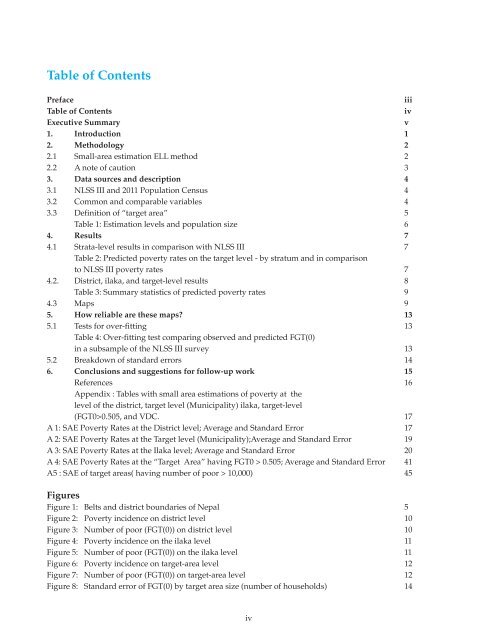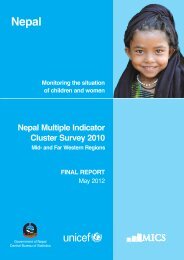Preface and AcknowledgementsThis report is a collaborative effort <strong>of</strong> Government<strong>of</strong> Nepal-Central Bureau <strong>of</strong> Statistics (CBS), and TheWorld Bank Group. It presents the result <strong>of</strong> small areaestimation techniques to further improve and extendthe sample survey estimates <strong>of</strong> poverty. The NepalLiving Standard Survey III presented the estimates<strong>of</strong> poverty for 12 analytical domains only. However,the demand for poverty estimates for administrativeregions smaller than an analytical domain is increasingbut implementing a sample survey which providesestimates at this great detail is prohibitively expensive.In this context, an advanced and cost effective statisticaltechnique called <strong>Small</strong> <strong>Area</strong> <strong>Estimation</strong> (SAE) provedto be a boon for Nepal. This method gives estimates<strong>of</strong> poverty for smaller areas by mixing the results <strong>of</strong>latest results <strong>of</strong> living standard survey and PopulationCensus.The CBS and its development partners (The WorldBank and the World Food Program) published ilakalevel poverty maps in 2006 using the SAE techniquecombining NLSS 2003-04, NDHS 2001 and Census2001. Village Development Committee (VDC) levelpoverty estimates are highly demanded by planners,researchers and development partners. This reportpresents the poverty estimates at subilaka level(target area) using SAE technique. The report containspoverty incidence (p0 or FGT0), poverty gap (p1or FGT1) and squared poverty gap (p2 or FGT2) foreach <strong>of</strong> 75 districts, 976 Ilakas and 2344 target areasincluding all municipalities individually. Though allVDC level poverty estimates are not produced because<strong>of</strong> imprecise nature <strong>of</strong> such estimates with smallsample number <strong>of</strong> households inhabiting same VDC,confidence intervals are provided for all 3973 VDCsand municipalities.From the World Bank, the general direction wasprovided by Vinaya Swaroop, Sector Manager andTahseen Sayed, country Manager, Nepal. PeterLanjouw, Marleen Marra, Prem Sangrula and SrinivasanThirumalai (Task Team Leader) worked with a team <strong>of</strong>CBS staff.CBS staff from the Household Survey, Population, Dataprocessing & GIS and Prices sections worked togetherto produce the report under the general guidance<strong>of</strong> Bikas Bista, Deputy Director General <strong>of</strong> CBS. Thecore team <strong>of</strong> CBS staff comprised <strong>of</strong> Dilli Raj Joshi,Devendra Karanjit, Jay Kumar Sharma and GyanendraBajracharya (Directors), Dinesh Bhattarai, Lok BahadurKhatri, Bed Prasad Dhakal, Binod Saran Acharya, BikasMalla, and Tulsi Paudel (Statistics Officers).GIS help for creation <strong>of</strong> new shapes and visualizationwas ably provided by Brian Blankespoor (The WorldBank). Chris Gerrard, and Minh Cong Nguyen(The World Bank) helped immensely with Tableaucustomization for developing the online query tool. Theteam would like to thank peer reviewers Pr<strong>of</strong>essor ChrisElbers, Pr<strong>of</strong>essor Pushkar Bajracharya, T.S. Bastola andMaria Eugenia Genoni. Also, the team would like tothank the participants <strong>of</strong> the review meeting held at theNational Planning Commission and a meeting attendedby researchers and policy makers in Nepal.The full report and the online query and visualizationtool can be accessed from the website <strong>of</strong> the CBS athttp://www.cbs.gov.np. Also, the entire report and<strong>of</strong>fline query tool is available in the CD attached withthis book.Uttam Narayan MallaDirector GeneralCentral Bureau <strong>of</strong> Statisticsiii
Table <strong>of</strong> ContentsPrefaceiiiTable <strong>of</strong> ContentsivExecutive Summaryv1. Introduction 12. Methodology 22.1 <strong>Small</strong>-area estimation ELL method 22.2 A note <strong>of</strong> caution 33. Data sources and description 43.1 NLSS III and 2011 Population Census 43.2 Common and comparable variables 43.3 Definition <strong>of</strong> “target area” 5Table 1: <strong>Estimation</strong> levels and population size 64. Results 74.1 Strata-level results in comparison with NLSS III 7Table 2: Predicted poverty rates on the target level - by stratum and in comparisonto NLSS III poverty rates 74.2. District, ilaka, and target-level results 8Table 3: Summary statistics <strong>of</strong> predicted poverty rates 94.3 Maps 95. How reliable are these maps? 135.1 Tests for over-fitting 13Table 4: Over-fitting test comparing observed and predicted FGT(0)in a subsample <strong>of</strong> the NLSS III survey 135.2 Breakdown <strong>of</strong> standard errors 146. Conclusions and suggestions for follow-up work 15References 16Appendix : Tables with small area estimations <strong>of</strong> poverty at thelevel <strong>of</strong> the district, target level (Municipality) ilaka, target-level(FGT0>0.505, and VDC. 17A 1: SAE <strong>Poverty</strong> Rates at the District level; Average and Standard Error 17A 2: SAE <strong>Poverty</strong> Rates at the Target level (Municipality);Average and Standard Error 19A 3: SAE <strong>Poverty</strong> Rates at the Ilaka level; Average and Standard Error 20A 4: SAE <strong>Poverty</strong> Rates at the “Target <strong>Area</strong>” having FGT0 > 0.505; Average and Standard Error 41A5 : SAE <strong>of</strong> target areas( having number <strong>of</strong> poor > 10,000) 45FiguresFigure 1: Belts and district boundaries <strong>of</strong> Nepal 5Figure 2: <strong>Poverty</strong> incidence on district level 10Figure 3: Number <strong>of</strong> poor (FGT(0)) on district level 10Figure 4: <strong>Poverty</strong> incidence on the ilaka level 11Figure 5: Number <strong>of</strong> poor (FGT(0)) on the ilaka level 11Figure 6: <strong>Poverty</strong> incidence on target-area level 12Figure 7: Number <strong>of</strong> poor (FGT(0)) on target-area level 12Figure 8: Standard error <strong>of</strong> FGT(0) by target area size (number <strong>of</strong> households) 14iv
















